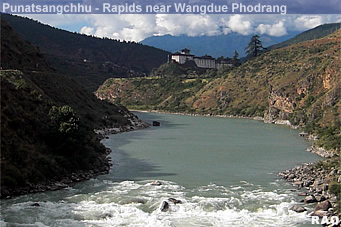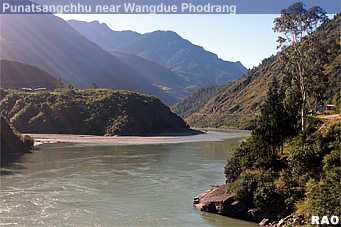 |
Bhutan Agriculture |
|
 |
Bhutan Information |
|
|
|
|
Bhutan
water partnership launched
|
 |
 |
| Although
only a fraction of its hydropower potential is harnessed, Bhutan already
generates about 40 percent of its total revenue from power. But population
growth, deveopment, urbanisation and the change in land use pattern will
aply more pressure on the water resources.
Already
there is seasonal water scarcity for drinking and agricultural purposes.
All these will eventually disturb the hydrology of the river.Thus the necessity
to come up with proper management structures, proper legislation and manpower
skills and baseline data within the water sector. |
|
|
Officially,
Bhutan has a forest cover of about 72 percent and an abundant water resource
which, theoretically,
can generate over 30,000 MW of power.
|
 |
An
initial momentum in this direction was begun with the launch of the Bhutan
Water Partnership on August 27. The entity is the first water body in the
country - an inter-ministerial organisation with a mandate to coordinate
and prepare policy documents, strategic vision documents and actionplans
in the water resource sector. "Water is on the global agenda because water
security is going to be the most crucial problem confronting humanity in
the 21 century," said Lyonpo Kinzang Dorji who launched the partnership.
"Bhutan is no exception." He warned that Bhutan couldn't afford to be "complacent"
though it was in a "comparatively better situation.
"Water is a cross-cutting
issue because of its universal utility. It is a social and an economic
good, which transcends social barriers. Therefore watercannot be treated
in a compartmentalized domain of the different users," said Lyonpo Kinzang
Dorji. "Hydropower potential without a soundwatershed conservation and
management has no meaning," he added.
Established
under the initiative of the ministry of agriculture the body has right
now 14 members from different organisations who deal with water. In an
official report written a few years back, a senior power official said
that the protection of the catchment areas is the singlemost important
wayto sustain Bhutan's hydropower development plans. "The preservation
of the catchment areas is critical to ensure dependable and perennial river
discharges. This is also directly linked to thesedimentation, which is
a consequence of degradation in the catchments area. As a priority, the
national strategy should pass legislation protectingthese watersheds,"
he said. The industries and the urban population were the primary beneficiaries
of Bhutan's rich water resources, said Kesang Jamtsho, project manager
of theintegrated resource management project.
"In hydropower pricing, the
watershed conservation cost has to be included and that's where the plough
back mechanism comes in," he said. "And also the social cost. Who will
compensate the farmers?" "In the preference ranking of the use of water,
drinking water has to be in the first place - it's a human right," said
Kesang Jamtsho, adding that itshould be followed by food security, which
means water for irrigation. After that, whether it will be hydropower or
for industries, is arguable, he said. The ministry of agriculture will
be requesting the government to allocate funds from the revenues generated
by hydropower for protection andconservation of watersheds.
The
director of the department of power, Sonam Tshering, said that the establishment
of the body was a "very good idea" and that it will help to lookat water
in a coordinated way. "The main drawback is that we cannot achieve peaking
power," he added. For example, although Chukha Hydropower Corporation has
the capacity to generate 336MW, in the winter it can generate only about
67MW (about 20 percent) due to less volume of water. When the generation
is most needed during winter due to greater use of electricity, the power
generated is minimum. If the watershed is not conserved and managed well
thedifference will be further widened. The power director agreed that the
plough back mechanism is a good idea for long term sustainability. "We
cannot believe that water is an infiniteresource," he added.
However,
the compensation for the farmers may come in solar power, which the power
department is planning to provide free of cost to the ruralareas where
hydroelectricity cannot be reached. The deterioration of catchment areas
also directly affects the sediment content in the rivers, which will not
only erode the turbine blades but alsoreduces the lifetime of the blades
and the efficiency. The document for national environment strategy for
Bhutan states that the three main avenues for sustainable development are
expanding hydropower,increasing agriculture self-sufficiency and expanding
the industrial base. "Water is the key component of all the three avenues,"
asserted Kesang Jamtsho.
Another
important document Bhutan 2020 states that the effective management of
watersheds must be considered a key component of Bhutan's efforts toplace
the nation's development on a sustainable path. Dr. Pema Gyamtsho, head
of the policy and planning division of the ministry of agriculture, said
that Bhutan started taking water seriously after the glacial outburst of
1994, the flood of 1999 and the draught of 1998-99 (winter and spring).
The director of forest, Ugyen Thinley said that the body has come at the
"right time" and that the watersheds management is a "big job" though thereare
already rules to conserve the watersheds. According to Kesang Jamtsho,
the entity should be able to come out with a Bhutan Water Vision for the
next 25 years within two years and the draftof the Water Act within three
years.
| Contributed
by KUENSEL, Bhutan's National Newspaper |
 |
| Information on Bhutan |
 |
|




